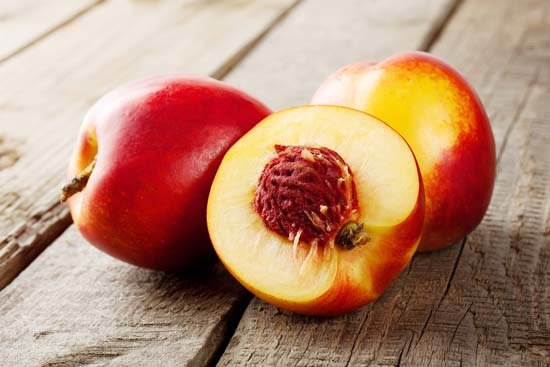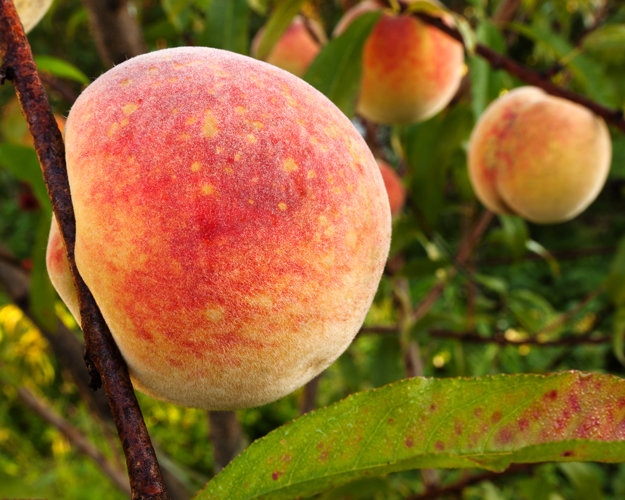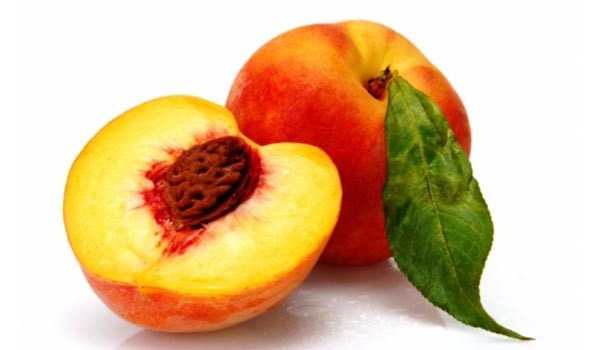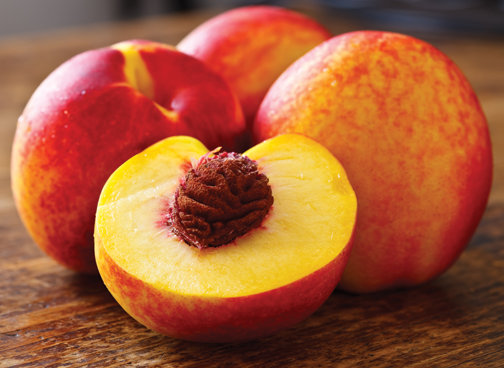- Overview
Common name: Peaches Botanical name: Prunus Persica Family: Rosaceae Origin China Avg. Height: 5-10 Meters Peach Tree Grafted in a 3 Gallon Container. Through a breeding program that began in 1953 the University of Florida successfully developed numerous low chill peach varieties suitable to Florida’s mild climate. The varieties we carry will grow and produce fruit even as far south as Miami. In fact, they have fruited successfully in Cuba and Nassau, Bahamas. The fruit quality is equal to that of temperate-zone cultivars, and small commercial plantings can be found throughout central Florida. The trees are deciduous and lose their leaves each winter, but they are highly ornamental otherwise making them an excellent choice for the home garden.
Description
Cultivation
Diseases
Planting
Watering
Fertilizing
Tips for Good Fruit
Peaches in Asian TraditionPeaches and nectarines are relatively large fruits with large, deeply ridged stones. Fruit 2 to 3.5 inches diameter. Peach fruits are pubescent throughout the growing season, and are usually brushed by machine prior to marketing to remove most of the pubescence. Nectarines have a smooth, plum-like peel. Nectarines have apparently originated from peaches by mutation. Trees of the two kinds are indistinguishable and are relatively small, usually held to under 15 feet by pruning. Both peaches and nectarines may be freestone - pit relatively free of the flesh - or clingstone - pit adheres to flesh. Many varieties, especially of peaches, are grown in the U.S., varying in season of ripening and climatic adaptation
Description
The Peach (Prunus persica) is a tree native to China that bears a juicy fruit called a peach. It is a deciduous tree growing to 5–10 m tall, belonging to the subfamily Prunoideae of the family Rosaceae. It is classified with the almond in the subgenus Amygdalus within the genus Prunus, distinguished from the other subgenera by the corrugated seed shell. The leaves are lanceolate, 7–15 cm long and 2–3 cm broad. The flowers are produced in early spring before the leaves; they are solitary or paired, 2.5–3 cm diameter, pink, with five petals. The fruit is a drupe, with a single large seed encased in hard wood (called the "stone" or "pit"), yellow or whitish flesh, a delicate aroma, and a velvety skin that bruises easily. The seed is red, oval shaped and 1.5-2 cm thick. Peaches, along with cherries, plums and apricots, are stone fruits (drupes). The scientific name persica derives from an early European belief that peaches were native to Persia (now Iran). The modern botanical consensus is that they originate in China, and were introduced to Persia and the Mediterranean region along the Silk Road before Christian times. Cultivated peaches are divided into "freestone" and "clingstone" cultivars, depending on whether the flesh sticks to the stone or not; both kinds can have either white or yellow flesh. Peaches with white flesh typically are very sweet with little acidity, while yellow-fleshed peaches typically have an acidic tang coupled with sweetness, though this also varies greatly. Both colors often have some red on their skin. Low-acid white-fleshed peaches are the most popular kinds in China, Japan, and neighboring Asian countries, while Europeans and North Americans have historically favored the acidic, yellow-fleshed kinds.
Cultivation
Peach trees grow very well in a fairly limited range, since they have a chilling requirement that subtropical areas cannot satisfy, and they are not very cold-hardy. The trees themselves can usually tolerate temperatures to around -26 °C to -30 °C, although the following season's flower buds are usually killed at these temperatures, leading to no crop that summer. Flower bud kill begins to occur at temperatures between -15 °C and -25 °C depending on the cultivar (some are more cold-tolerant than others) and the timing of the cold, with the buds becoming less cold tolerant in late winter. Certain cultivars are more tender and others can tolerate a few degrees more cold. In addition, a lot of summer heat is required to mature the crop, with mean temperatures of the hottest month between 20 °C and 30 °C. Another problematic issue in many peach-growing areas is spring frost. The trees tend to bloom fairly early in spring, around the same time as daffodils. The blossoms can often be damaged or killed by freezes - typically, if temperatures drop below about -4 °C, most blossoms will be killed. However, if the blooms are not fully open, they can tolerate a couple degrees colder. Important historical peach-producing areas are China and Iran, the Mediterranean states like Italy, Spain and Greece. More recently, the U.S. (Alabama, California, Colorado, Delaware, Georgia, Maryland, Michigan, New Jersey, Oregon, South Carolina, Texas, Utah, Virginia, Washington, West Virginia, Puerto Rico), with the three largest producers being California, South Carolina, and Georgia, respectively. Canada (southern Ontario and British Columbia), and Australia (the Riverland region) have also become important. Oceanic climate areas like the Pacific Northwest and the British Isles are generally not satisfactory for peach growing due to inadequate summer heat, though they are sometimes grown trained against south-facing walls to catch extra heat from the sun. Trees grown in a sheltered and south-facing position in the British Isles are capable of producing both flowers and a large crop of fruit. Peaches trees are the second most commonly cultivated fruit trees in the world after apple trees.
Diseases
Main article: List of peach and nectarine diseases Most peach trees sold by nurseries are grafted cultivars. The trees are prone to a disease called leaf curl, which usually does not directly affect the fruit but does reduce the crop yield by partially defoliating the tree. The fruit is very susceptible to brown rot.
Planting
It is also possible to grow a tree from either a Peach or Nectarine seed. The germinated seed requires a south or west-facing position and regular watering. Peaches should be located in full sun, and with good air flow. This allows cold air to flow away on frosty nights and keeps the area cool in summer. Peaches are best planted in early winter, as this allows time for the roots to establish and be able to sustain the new spring growth. When planting in rows, plant north-south.
Watering
For optimum growth, peach trees require a constant supply of water. This should be increased shortly before the harvest. The best tasting fruit is produced when the peach is watered throughout the season. Drip irrigation is ideal, at least one dripper per tree. Although it is better to use multiple drippers around the tree, this is not necessary. A quarter of the root being watered is sufficient.
Fertilizing
Peaches have a high nutrient requirement, needing more nitrogen than most other fruit trees. An NPK fertilizer can be applied regularly, and an additional mulch of poultry manure in autumn soon after the harvest will benefit the tree. If the leaves of the peach are yellow or small, the tree needs more nitrogen. Blood meal and bone meal, 3–5 kg per mature tree, or calcium ammonium nitrate, 0.5–1 kg, are suitable fertilizers. This also applies if the tree is putting forth little growth.
Tips for Good Fruit
If the full amount of peaches is left, they will be under-sized and lacking in sugar and flavour. In dry conditions, extra watering is important. The fruit should be thinned when they have reached 2 cm in diameter, usually about 2 months after flowering. Fresh fruit are best consumed on the day of picking, and do not keep well. They are best eaten when the fruit is slightly soft, having aroma, and heated by the sun.
Peaches in Asian Tradition
Pan Tao, the Chinese flat peachPeaches are known in China, Japan, Korea, and Vietnam not only as a popular fruit but for the many folktales and traditions associated with it. Momotaro, one of Japan's most noble and semi-historical heroes, was born from within an enormous peach floating down a stream. Momotaro or "Peach Boy" went on to fight evil oni and face many adventures. The flowers of the flowering peach are admired by the Japanese but not as much as the sakura (cherry). In China, the peach was said to be consumed by the immortals due to its mystic virtue of conferring longevity on all who ate them. The divinity Yu Huang, also called the Jade Emperor, and his mother called Xi Wangmu also known as Queen Mother of the West. Xi Wangmu ensured the gods' everlasting existence by feeding them the peaches of immortality. The immortals residing in the palace of Xi Wangmu were said to celebrate an extravagant banquet called the Pantao Hui or "The Feast of Peaches". The immortals waited six thousand years before gathering for this magnificent feast; the peach tree put forth leaves once every thousand years and it required another three thousand years for the fruit to ripen. Ivory statues depicting Xi Wangmu's attendants often held three peaches. The peach often plays an important part in Chinese tradition and is symbolic of long life. One example is in the peach-gathering story of Zhang Daoling, who many say is the true founder of Taoism. Elder Zhang Guo, one of the Chinese Eight Immortals, is often depicted carrying a Peach of Immortality. The peach blossoms are also highly prized in Chinese culture, ranked slightly lower than mei blossom. It was under a peach tree that Liu Bei, Guan Yu, and Zhang Fei took an oath of brotherhood in the opening chapter of the classic Chinese novel Romance of the Three Kingdoms. Due to its delicious taste and soft texture, in ancient China "peach" was also a slang word for "young bride", and it has remained in many cultures as a way to define pretty young women (as in English, with peachy or peachy keen). - Features
weight: 9.99 lbs : - ReviewsThere is no reviews yet...Be the first!
Be the first to write a review of this product!









